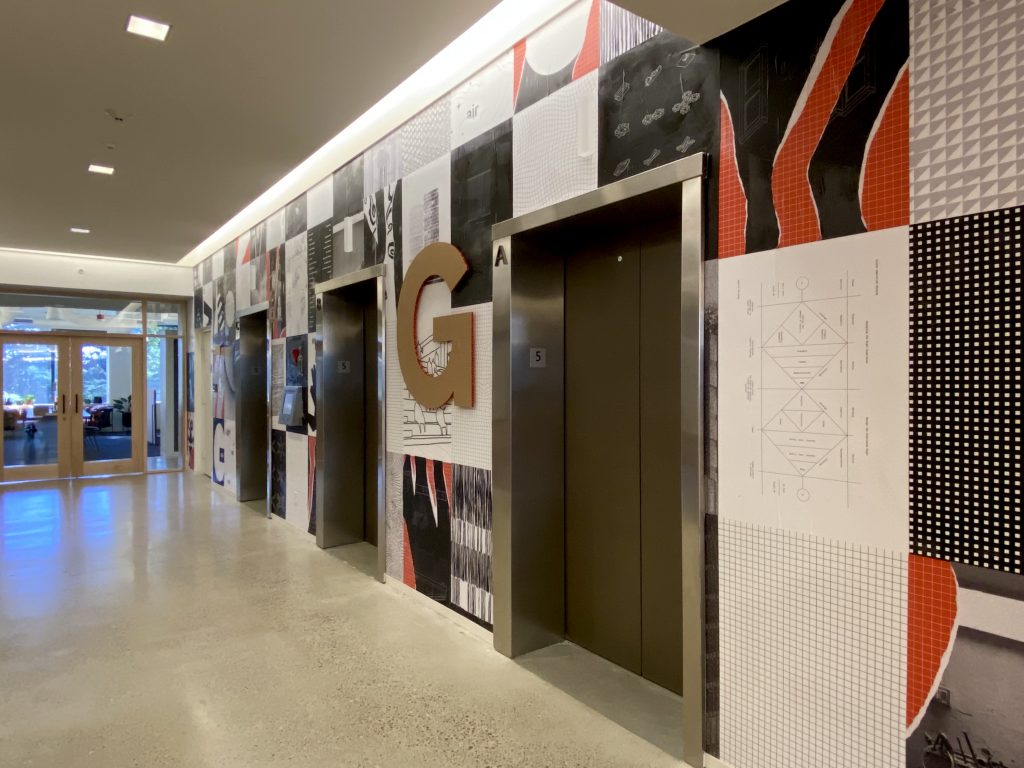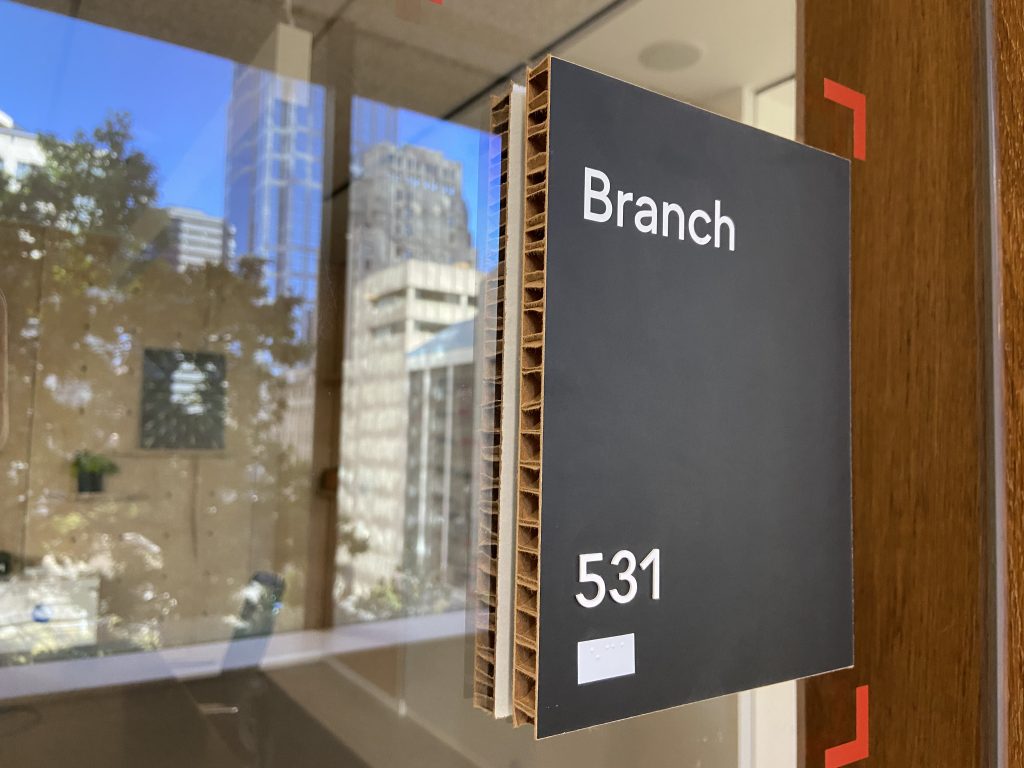By Alex Burkholder and Peter Muller
Establishing, tracking, and meeting carbon goals is a very challenging and time-consuming undertaking. With many corporate spaces currently under lease and a projection that two-thirds of today’s building stock will still exist by 2040, to remain competitive we know that existing workplace portfolios will likely need just as much attention given to carbon reduction as they do for the strategic expansion into new markets.
While it may seem intuitive to begin tackling these challenges by focusing on the largest areas of impact first, to paraphrase Desmond Tutu, we know the best way to eat an elephant is one bite at a time. So, when looking for an impactful, actionable, and timely way to move the needle in support of environmental, social, and governance (ESG) and carbon goals, we suggest starting with a fundamental, yet often overlooked tool: signage.
Follow the signs
Often an afterthought or below-the-line budget item, signage can have a surprisingly large impact on carbon goals. Signage is a major brand touchpoint. A sign system’s look and feel, functionality, and messaging all contribute to the experience a company cultivates as a brand. Think about navigating an airport, for example. Expertly designed, messaged, and programed signage can make the difference between arriving at your gate relaxed and on-time or completely missing your flight. With the majority of signs being required by way of the ADA (American Disabilities Act), signage also significantly advances tenets of inclusive and accessible design experiences. It’s a communication vehicle to telegraph wayfinding directions, but also a brand’s values, intent, and corporate priorities.

Gensler Seattle’s net-positive embodied carbon signage system.
In 2020, Gensler’s Seattle and San Francisco signage teams partnered with a client that has a commitment to reach net-zero carbon emissions by 2040. Their challenge to Gensler was simple: reduce the embodied carbon footprint of their interior signage. We responded by designing an Embodied Carbon Calculator, developed to specifically identify and compare the embodied carbon in materials most commonly used in interior signage systems, which became a critical tool as we navigated feasibility and prototyping while ensuring high levels of alignment with our client’s brand standards and quality expectations.
We extracted GWP (Global Warming Potential) data from EPDs (Environmental Product Declarations) for a variety of materials — some of which they were already using and others we wanted to start using — and developed a baseline. We quickly discovered that by deprioritizing petroleum-based products like acyclic and prioritizing more natural and responsibly sourced, environmentally friendly materials like cardboard, wood, and post-consumer recycled composites, we were able to reduce the embodied carbon footprint by an astounding 393 kilograms of Co2 per 20,000 square feet of signed interior workplace — the equivalent of preventing 435 pounds of coal from being burned every time this sign system is implemented. Scale that up across their global interior workplace portfolio and the savings become really impressive.
It was a lightbulb moment for the team. This finding was so inspiring and impactful, the client touted it in a change campaign to employees as an example of their authentic brand commitment to meeting their carbon goals. Alongside authenticity, we know that transparency and impact are more important than ever. As Gensler’s 2022 Design Forecast notes, “Organizations will be expected to show their impact. Millennials and Gen Z expect companies to clearly demonstrate their public purpose, so brands are increasing transparency and showing measurable accomplishments to cultivate trust from the communities they serve.”

Gensler Seattle’s net-positive embodied carbon signage system.
A sign of change
Millennials and Gen Z will make up over 50% of the workforce by 2025 in OECD countries, according to Deloitte. Along with fresh perspectives and skillsets, these generations also bring with them a shift in mindset from earlier corporate workers. Today’s younger employees see alignment of purpose as both relevant and attractive reasons to choose a brand or employer. It’s less about what they do and where they work, and more on WHY they work.
Millennials and Gen Z have a much stronger affinity and investment in our world’s sustainability than their predecessors. Limiting the impacts of climate change is something in which they are personally invested. And with daily headlines filled with alarming predictions facing the world’s natural resources, it’s not surprising that both generations rank climate change as their second greatest concern after cost of living. With the built environment generating nearly 50% of global carbon emissions, those on both sides of the design industry — real estate and facilities teams on the client side, and architects and designers — have a responsibility and real opportunity to affect change and help corporations reach their carbon goals.

Gensler Seattle’s net-positive embodied carbon signage system.
Sign up
Since 2020, our aforementioned client has deployed their signage in approximately 1.5 million square feet of office space — the equivalent of preventing 32,625 pounds of coal from being burned. Our team has gone on to design low-carbon signage solutions in partnership with other forward-looking clients and we’ve designed and implemented a net-positive embodied carbon signage system for our new Seattle Gensler office. The Embodied Carbon Calculator has been broadly adopted by different Gensler offices for projects around the globe — and we’re challenging ourselves as a Brand practice to use it to meet both our client’s and Gensler’s own carbon goals.
Real estate, facilities, and leasing strategies are a long-term game, and it can be hard to demonstrate progressive, steady commitment to corporate sustainability goals. Signage and wayfinding is a code necessity; it’s probably already built into most capital expense and operational expense budgets. An update to use sustainable, flexible, and resilient materials is an easy and scalable way to put an organization’s carbon commitments in front of team members daily, helping them navigate the world and enabling companies and brands to speak authentically to their commitments. Just follow the signs.
Alex Burkholder
Alex is a Brand Design Leader for Gensler’s Northwest region and Studio Director co-leading Brand Design and strategy practices in Gensler’s Seattle office. He has over 15 years of extensive experience with brand design and wayfinding strategy, managing signage, brand, brand strategy, and interiors experiences for diverse clients in technology, education, finance, and consumer goods.
Peter Muller
Peter is a dynamic design manager with 10 combined years of experience in project management, branding, and technical sign manufacturing. As a Global Design Resilience Leader, Peter leads Gensler’s Brand Design practice in sustainable brand design solutions, client advocacy, talent development, and environmentally responsible brand strategy. He is based in Seattle.
By Alex Burkholder, Brand Design Leader and Peter Muller, Global Design Resilience Leader at Gensler



You must be logged in to post a comment Login